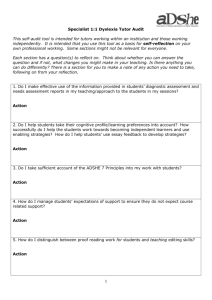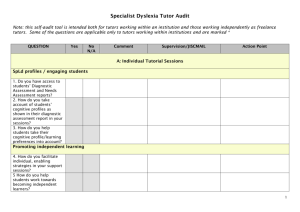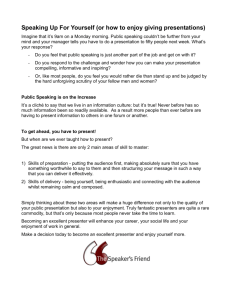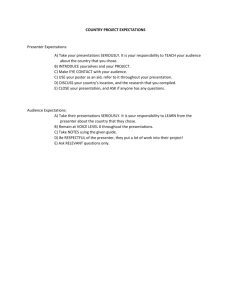ADSHE QUALITY ASSURANCE POLICY
advertisement
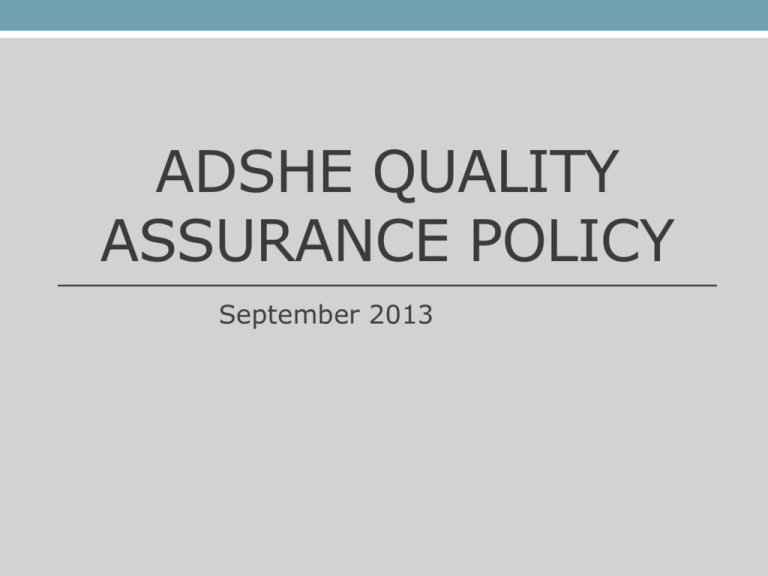
ADSHE QUALITY ASSURANCE POLICY September 2013 Overview Why is QA important? Professional Peer Supervision ADSHE REGISTER Self-audit tool Background Quality Assurance Working Party set up in June 2010 to build on work from Guidelines for establishing Quality Assurance protocols To design CPD self-audit tools To introduce peer supervision (PPS) models To set up a register of dyslexia specialist tutors To provide good practice guidelines and set up standards for dyslexia specialists to follow The Wider Context Setting standards in the sector Ways of ensuring quality assurance for non-medical helpers across the sector Business Innovation & Skills Student Finance England Eventually some form of QA mandatory Crucial that ADSHE sets the standards for QA in HE Why is QA important? To demonstrate that dyslexia specialists have a variety of effective ways of monitoring and quality assuring dyslexia support across HEIs Interested parties: students; funding bodies; institutions; Dyslexia Professional Body (ADSHE) QA is accountable, transparent and consistent with the clear aim of ensuring best practice across the sector ADSHE QA Policy ADSHE Quality Assurance Policy Professional Standards An ADSHE Register of professionally qualified tutors who undertake regular CPD including supervision A list of ADSHE registered tutors available for freelance work Demonstrates that dyslexia specialists have a variety of effective ways of monitoring and quality assuring dyslexia support across HEIs Policy Appendices Membership Code of Ethics Complaints Procedure Appropriate qualifications Membership categories 1. Ordinary member – individual Professionals qualified to work in a 1:1 tutorial support capacity with SpLD students in higher education Specialist tutors with experience of working in a 1:1 tutorial support capacity with SpLD students in higher education 2. ADSHE registered member 3. Student member 4. Invited member Professionals (including Educational Psychologists and Disability Officers) working in the field of dyslexia/SpLDs, who are not necessarily Specialist SpLD tutors. Applying to be on the Register Provide evidence of qualifications Agree to abide by ADSHE QA procedures (Code of Ethics, Quality Assurance Policy and Guidelines) Keep a log of CPD activities and provide evidence of CPD (self-audit tool; professional peer supervision Provide evidence of recent specialist 1:1 tutorial experience ADSHE Freelance List Registered members can opt to be put on ADSHE Freelance List of Specialist SpLD tutors Evidence required on yearly basis: • current CRB clearance • professional indemnity insurance • Evidence of teaching CPD Reflection on practice e.g. self-audit tool Supervision (e.g.PPS) Updating skills Attendance at conferences/training days Research into relevant topics Critical reading e.g. review chapter in book, newsletter contribution; current research; presentation Self-audit tool A tool for selfreflection on your own professional practice Questions are designed to trigger reflection No right or wrong ‘answers’ Note action you need to take Can be used individually or in groups What is PPS? A way of using reflective practice and shared experiences Part of continuing professional development (CPD) It can provide opportunities for reflection/ developing expertise Gaining professional support Identifying concerns/issues to enable practitioners to strive for best practice 14 Benefits of PPS Evidence engagement in peer supervision Mutual support Increase insight Share common experiences Learn new techniques/strategies Solve complex tasks 15 Structure of PPS Group or 1:1? 1 supervisor; 1 supervisee 1 supervisor; 4-6 supervisees Team – colleagues working together 16 Format What type of topic/discussion? How record the session? How to offer feedback? How to evaluate? 17 Good questions to ask yourself before embarking on PPS What do I want to get out of my PPS sessions? How often do I meet and where? What can I bring to the PPS role? How might I go about preparing myself? Active listening Importance of careful listening, focussing on the other person Ask open, objective questions to help speaker clarify own thoughts Resist offering advice solutions or personal anecdotes (unless requested) SOLER S – face the presenter SQUARELY, in a positive manner which shows you are giving your full attention. O – Adopt an OPEN posture to show that you are ready to listen and engage with what the presenter is saying. L – If appropriate, LEAN towards the presenter to show that you are engaging fully. E – Maintain EYE contact. R – Keep a RELAXED attitude i.e. not fidgeting or distracting the presenter in any way and showing that you are comfortable with the presenter. McGill and Brockbank (2004) Careful questions: Open questions Contracting questions Clarifying Challenging questions questions Catalytic questions ABC Model • Awareness of issue • Beliefs about issue • Consequences – emotional and behavioural. It will then be possible to work through: • Disputing beliefs related to the issue and then try to plan • Effective response to issue CLEAR model C L E A R •Contract: Agreeing basic ground rules and roles; establishing outcomes. •Listen: Active listening by supervisor to understand supervisee and work. •Explore: Working together to create different responses to issues through questioning, reflection and offering fresh insight and awareness. •Action: After exploring different options, the supervisee chooses a way forward and agrees the first steps. ‘Fast-forward rehearsal’ •Review: Review the actions. Feedback about the supervision process. Planned future action. GROW model G R • Establish the GOAL • What do you want? • Examine the reality • Uncover real issues; what has/has not worked O • Consider all the Options • Consider the • Draw out all possible solutions; selected preferred options W • Confirm the Will to Act / Way Forward • Discuss possible implications; commit to action/plan; identify support; check goal achieved PRACTICE coaching model 7 stages Problem identification Realistic Relevant goals Alternative solutions Consider the Consequences Target most feasible solutions Implementation of Chosen Solutions Evaluation Stephen Palmer (2008) Action learning Professor Revans introduced the concept of Action Learning to the business world in the 1940s. "Action learning is not new; like all organic growth it depends more upon the reinterpretation of old and familiar ideas than upon the acquisition of new cognitive knowledge” Revans (2011). Background Action Learning was originally intended for managers but it is ideally suited for experienced dyslexia practitioners Now used in many different contexts: business, education and the church Based on coaching models of supervision “There can be no learning without action and no action without learning” Revans (2011) .…… an opportunity to have regular and purposeful conversations about current uncertainties with the absolute intention of discovering new options Revans (2013) www.3dcoaching.com What the action learning process can offer you: A personal and professional development tool Support and challenge from peers. A ‘safe’ environment to explore new ways of thinking and practising Insight into how others achieve different solutions Space for individual reflective learning which can lead to action A fresh perspective on your working practices and time to think about creative ideas which you can incorporate in your regular work How does it work? Small groups (sets) of professionals work together on real life issues/situations to examine and challenge current ways of working. The presenter describes a situation, problem or challenge that they are currently working with. The facilitator keeps focus, reflects back and summarises. The set members help the presenter review his/her options. This helps the presenter reflect and come to a deeper or different understanding and decide on action. Details Other group members also ask questions – the facilitator prompts responses; comments on any questions which are not helpful At the end of the session the facilitator sums up what has been discussed and asked the presenter what they have learnt and what action they will take in consequence. The presenter takes what s/he has learnt back to their workplace – initiating changes and trying new ideas or approaches At the next meeting the presenter reports on the action they have taken. The role of the facilitator The facilitator initiates the meeting by asking the presenter what s/he wants to think about and what s/he hopes to gain from the meeting. (This is the contract). The facilitator ensures that the questioning is focussed and specific and that it is relevant to the Presenter and not the Set Members. The Role of the Set Members Set members ask questions, make observations and ensure that the Presenter has sufficient time for reflection. Before asking questions, it is helpful to think how useful the question is to the presenter. Set members should focus solely on listening to the presenter and what s/he is saying and helping him/her to gain clarity, not on how they would react in a similar situation. General Principles Group members do not give advice, tell anecdotes, pass judgement or talk about their own situations – their task is to stay focussed on the Presenter and his/her issue Each group member is responsible for resolving his/her own issues Other group members support and enable the Presenter to explore issues Empathy and confidentiality are essential Diagram to describe the Action Learning Journey References Hawkins P, Shohet R: Supervision in the Helping Professions. Berkshire, McGraw Hill Education 3rd edition (2011) McGill I, Brockbank A: The Action Learning Handbook. Oxon, Routledge (2004) Revans, R ABC of Action Learning (2011) Tower Publishing Limited: Farnham Rogers, J: Coaching Skills - A Handbook. Berkshire, Open University Press 3rd edition (2012)
